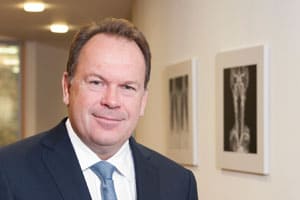
John Dineen has spent more than 25 years at GE, working in divisions as diverse as telecommunications, transport and plastics.
But it was his 2008 appointment as president and CEO of GE Healthcare that allowed him to combine the biology, genetics and computer science he studied to degree level with this industrial experience.
He explains how the knowledge gained working across different GE divisions has informed where the company is heading in healthcare.
“In healthcare sometimes you can get enamoured with the technology and pursue technology for the sake of technology. We’ve put a bit of an industrial edge on our thinking here. We look at what our partners in the life sciences business, in the pharma space, need to be more competitive, to be more productive, and we look at medicine the same way.”
His company has a broad range of technology interests, covering areas such as electronic medical records, home health and diagnostic imaging.
But it’s in molecular medicine that GE Healthcare connects most directly with biopharmaceutical companies, building biotherapy manufacturing capability and developing diagnostics.
“We are already a significant partner to the biopharmaceutical industry through our life sciences business,” says Dineen.”Now we are investing heavily to make sure we can continue to help biopharma companies answer their challenges in areas like cell-based therapies and manufacturing quality and efficiency, and act as an enabler in research, development and process technology.”
Diagnostics and pharma
These investments all boost GE’s standing in diagnostics, an area that is assuming particular importance to the pharmaceutical industry as companies strive to match more closely their therapies to the patients that they can benefit.
“You’re seeing our diagnostic world and the biopharma world starting to work a lot more together,” explains Dineen.
“The intersection between the two worlds is really starting to take shape and it’s changing our business and the way we think about it, and it’s changing the way pharma thinks about the diagnostic world.”
The company has been a world leader in diagnostics for a long time, since the invention of X-ray in the late nineteenth century, in fact, and in the 21st century GE finds itself moving ever closer to pharma.
The company’s molecular medicines base is, Dineen says, at the intersection of radiology and molecular biology, and its presence in the area further increased last year with the acquisition of cancer diagnostics company Clarient.
Clarient has a number of ongoing projects with cancer therapeutics companies that focus on aligning diagnostic techniques with key drug targets.
“Clarient has taken us from the in vivo diagnostics to the in vitro diagnostics world and it’s an important step,” Dineen says. “We’ve been doing a lot of molecular diagnostics in the PET world, in the tracer world. Now we’re in the tissue diagnostics space as well.”
GE also wants to harness Clarient’s capabilities and skills in diagnostic discovery, development, validation and central lab services to work with biopharma companies throughout the drug development processes.
GE has already worked on many biopharma projects and its current work programme includes collaborations with biopharma partners to evaluate exploratory biomarkers in early-stage clinical trials, with the hope that some of these markers can be converted into a companion diagnostic product after the completion of a late-stage clinical trial.
“We’re working on more precise diagnostics, using Clarient and the technologies we have. We want to go from detecting breast cancer or prostate cancer to looking at what kind of breast cancer or prostate cancer is present, to help physicians make very important therapeutic decisions for a course of therapy. So we want to make diagnostics much more granular and bring them down to a molecular level.
“Rather than diagnosing a tumour or physiological problem, we’re really trying to diagnose a molecular problem. We have to know whether there is a therapy for a disease, what that therapy is and how it works. We can then ensure our diagnostic is closely coupled with the therapeutic capability. That’s a sea change in the diagnostic world – a sea change for people like us.”
Oncology is a focus area for the company and GE plans to dedicate $1bn of its healthcare R&D budget through to 2020 to expand its advanced cancer diagnostic and molecular imaging capabilities, as well as its technologies used in cancer research and for the manufacture of biopharmaceuticals.
GE Healthcare
The division Dineen leads is GE’s only business with its headquarters outside the US. From a base close to London in Chalfont St Giles, Buckinghamshire, he oversees a $17bn business, with interests that include healthcare equipment, IT and service management.
GE Healthcare was set up through the 2004 acquisition of Amersham, which was combined with GE Medical Systems and GE Healthcare Technologies. Its European R&D operations include bases in France for diagnostic imaging technologies, Sweden for life sciences development, Wales for stem cell work and Chalfont St Giles for molecular diagnostics.
Although operating with, rather than in, pharma, there are many parallels between GE and the pharmaceutical sector.
In R&D terms, GE runs a very high-tech business, developing technology that requires a tremendous amount of funding and its molecular diagnostics business has a development cycle that is much like that seen in pharmaceuticals.
Healthcare cost drivers in Europe
Like pharma, GE also faces similar pressures from the healthcare cost-reduction measures sweeping Europe.
The region is approaching a “bow wave of demand”, Dineen says, as more people need more healthcare, but cost remains a key driver.
“Europe and the US are very interested in more productive solutions. That’s why we find ourselves focusing a lot on IT, on our solutions and consulting businesses, on life sciences and molecular diagnostics.
“Molecular diagnostics, while they represent high technology and by themselves could be expensive, can also save a lot of money by identifying the right population of responders for an expensive biotherapy.
“We’re really in the same boat as pharma in terms of having to have clear and well-documented value propositions. I think what’s interesting is when it comes to the diagnostics, in the old world we could think about the diagnostic by itself and the diagnostic’s clinical and economic value proposition by itself. Today, I think we are being pushed to work much more closely with the pharmaceutical industry.
“So we work directly with therapy companies and biopharma to lay out the entire continuum from molecular diagnostic to in vivo diagnostic, PET diagnostic and therapy, and to change the entire diagnostic and therapy continuum.”
GE is also looking at ways to improve clinical delivery through the use of IT or lowering healthcare costs by offering different types of products.
Dineen uses the example of a more cost-effective MRI system – the Vscan pocket size visualisation tool that GE developed for use on specific joints. So, rather than having to go through the MRI, the patient sits in a chair and puts his arm or leg into it.
The idea is this makes it a more focused tool that not only provides better images at a fraction of the cost of a traditional MRI scanner, but that it also provides a better patient experience.
Molecular diagnostics, which by themselves could be expensive, can also save money by identifying the right population for an expensive biotherapy
“If you’ve ever been in an MRI, people aren’t crazy about being in that tube. Now they can just sit in a chair,” says Dineen.
Healthymagination
One of the influences on GE’s current thinking is its ‘healthymagination’ project. This looks at where the company wants to improve healthcare and then imagines how this might come about.
“We want to make an impact on the quality of healthcare, the cost of healthcare and the access, the reach of healthcare systems. For every one of our product lines we’re concerned with thinking how do I take a multipurpose tool and make it more of a scalpel than a Swiss army knife.”
Through the healthymagination programme, GE has so far invested $2.2bn in 43 technologies that address health challenges. It has also increased its partnerships with digital health experts like MedHelp, Healthline and WebMD as well as institutions like Grameen Bank and Intermountain Healthcare.
“This space can be driven by the pursuit of technology. We wanted to make sure that in today’s world we are pursuing relevant technologies, technologies that solve clinical and economic value propositions, often at the same time.
“You can solve a clinical problem, but not improve the economics of healthcare. It’s much more challenging when we ask our engineers to do both at the same time. How do I get a better clinical outcome and how do I improve the economics of healthcare? Healthymagination is that challenge.
“Europe is a classic healthymagination challenge in our view; more, sicker people demanding higher quality in a world where we’ve got tremendous economic strains in the public healthcare systems, be it Germany, France, Spain. You can say we’ll provide more access for people, but we’ve got to take cost down or quality down. But I don’t think people are prepared to make trade-offs. So we need to ‘bend the curves’, as they say.
“The only way you do that is with different technologies, like molecular medicine.”
Making a difference with diagnostics
“We’re making terrific progress, both on healthymagination and in changing the shape of this business and moving it to one that is really going to help lead in the world of molecular medicine.
“There are a lot of powerful tools and technologies in the business. At one level, you want to keep furthering those individual technologies, but at another level, starting to connect them with tools and technologies in our portfolio or in other people’s portfolio like the biopharma space. That’s where it gets interesting. That’s where the impact can be tremendous.
“Good diagnostics themselves are one thing. But if we can couple excellent diagnostics and the next generation of therapies and be able to bring them to market as comprehensive solutions, that’s where we’re going to make a hell of a difference in battling diseases like Alzheimer’s or cancers.
“We’re not going to be able to do that all by ourselves, and I don’t think the biopharma community can do that all by itself. But as we start to work together and work more closely, we’ve got a shot at really changing the game in those areas.”

The Interviewer
Dominic Tyer is managing editor of PME and PMLiVE




